What I Learned
at Wimbledon 2015
John Yandell
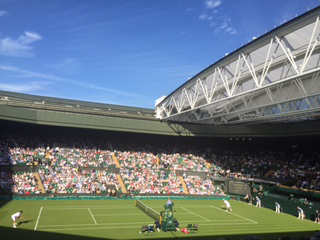
What did I learn at Wimbledon 2015? That Roger is the most graceful and balanced player I have ever seen. That the biomechanics of pro technique are truly invisible to the eye. That the mental game in a pro match can turn on one ball.
That the members' area at the All England Club is one of the coolest places there is in tennis. That the Lawn Tennis Association puts on very good coaching conferences.
I had the chance to learn these things when I was invited, along with Tennisplayer technical editor Giancarlo Andreani, to present at the LTA conference the weekend before the Championships, as the English like to call Wimbledon.
That was followed by two days of center court tickets--and access to the members area-- and that was the amazing gift from our good friends and noted British coaches Nicola Hall and Jane Poynder. Let's just say that it, all in all, was a fertile learning environment.
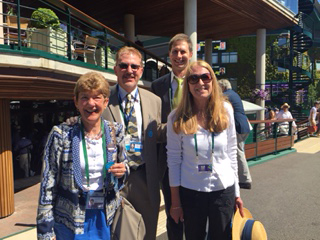
Roger First
When Giancarlo and I settled into our seats for Day 1 on Center Court to watch Djokovic, Federer, and Andy Murray all play their first round matches, I realized something. It was the first time in years I would be watching a match in person with my eyes instead of through the lens of a high speed camera.
All three players won and looked formidable. But I felt like I was watching pro tennis for the first time. I was feeling it as much as seeing it. But what I was seeing wasn't what I was used to seeing.
The grace and lightness and power of Roger's movement were overhwhelming. Always upright. Always on balance. Always looking effortless. Fluid, instantaneously explosive.
It was an aesthetic and emotional experience. I draw the line at calling it spiritual, but it made me dream of going out on the court and trying to dance with the same super human precision and balance.
The Human Eye
Which is related to my second learning experience. For so many years I have been using that incredible research resource we call the Tennisplayer high speed archive to try to understand the complexities of pro technique. And through that archive I found that it's possible to answer virtually any technical question about what the top players do.
This is because you can study literally hundreds of clips of the same player, or a group of players, from almost every angle, and do it frame by frame--something that is available nowhere else in the world. And yes, I created it in large part for myself to do this work.
Then you get the chance to watch Roger and these other champions live on Center Court after so long behind the camera. And you try to see the elements of the strokes you know are there--but now you are trying to see them with your eyes alone. And you start to ask questions.
When did the racket really turn over on that wiper finish on that forehand? Did the hand and arm and racket fully rotate in the extension on that serve? Was that really the same arm configuration you see in high speed video on that lasered two-handed backhand?
And I realized that this was the way the vast majority of fans, commentators, and players, and coaches, and teachers, and even elite pro tour coaches, have always studied the game (and still do...), trying to unravel these mysteries with their eyes.
And it made me realize how lucky I have been to be able to explore them using the instrument of the high speed camera. And how valuable the body of work we have on Tennisplayer really is, not just for me but for any other student of the game. And, yes, how far ahead of its time it really is.
And then I felt a brief moment of sympathy for the television commentators and the very stupid things they say over and over. (The "flick of the wrist" etc etc.) They may be former players and have great eyes but the reality is their eyes aren't fast enough either, and they can't really see what is happening. But the question then remains, why do they pretend that they can?
Witnessing The Mental Moment
Before going to Center Court on Day 1, Giancarlo and I decided to go watch an earlier first round match on the outer courts between Dominic Thiem and Dudi Sela, both players with absolutely gorgeous, huge, one-handed backhands.
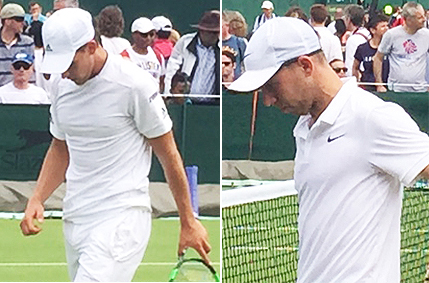
Sitting in the third row, again without the camera, I was amazed at how much you could feel of what the players were feeling themselves. Thiem was super tight, having trouble breathing even. He was hitting balls 4 and 5 feet long, got down 5-0, and lost the first 6-2. (Click Here to see his amazing backhand!)
Meanwhile Sela was ripping the ball fearlessly and freely--serves, backhands forehands, overheads. If you didn't know who the players were, didn't know their history and where they were in the rankings, you would have said Sela was clearly the better player.
Then on one ball the match reversed. It was 3 all in the second and Thiem hit a close ball on the sideline that Sela thought was out. After the point he went really, really crazy, shouting and screaming. It was very incongruous with what had been happening.
Two points later he was still making loud angry comments. And the match was basically decided. Thiem relaxed and won the next three sets 6-3, 6-4, 6-4.
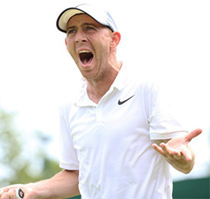
What happened? Thiem is 19 and a rising star. Sela is 30 and had dropped from the top 30 all the way down to 400 at one point. Now he was back in the top 100.
Thiem obvious expected to win and that pressure tightened him right up. But he showed a lot of maturity and strength of will. He was missing and missing. But he just kept going for his shots and walking away from his bad errors. He looked nervous but he didn't look negative.
Sela obviously felt no pressure at the start, but then after he won the first, it must have occurred to him that this win would a huge step in his comeback toward his former level. And that expectation was too much to overcome.
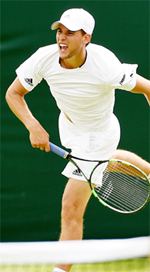
Although he was playing great tennis and Dominic was cooperating by making so many errors, his confidence was obviously paper thin. The first big negative event of the match, and that belief collapsed.
Every player who has played competitively has been through similar experiences, most likely on both sides of the story--sticking it out and turning a match around, or absolutely collapsing after some unexpected misfortune. Here was the exact same dynamic playing out a few feet in front of us at the game's highest level and most legendary venue.
The bottom line, Dominic believed he could win the match, and deep inside Sela didn't. It's easy to say things such as stay in the moment, keep trying, believe in yourself, go for your shots, shrug off adversity. And sometimes players are able to do it and sometimes they aren't.
And sometimes it's because they just kept making the effort to believe, and sometimes it's because they just didn't have it in them to try to believe, at least on that given day or for the length of the entire match on that given day.
Clotted Cream with the Members
GC and I were so confident of the outcome we left midway through the third set to get over to the members area and hang out before things started on Center Court. And what is that like, the members area?
Like nothing else I've seen in tennis. Even though I am 62 I felt like the youngest person there--except for Greg Rusedksi in his ray bans, and also a few very well behaved children.
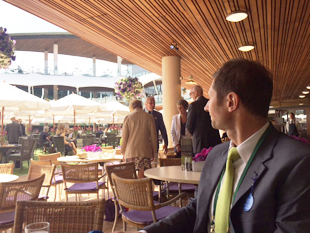
It's a summer ritual in which English ladies and gentleman dress in the same summer clothes they have worn to members area for years or possibly decades.
Let's just say the styles go back to the 1960's and 1970's. Double breasted jackets, some in bright colors, stripped shirts with the white collars, super wide ties. Sheer flower patterned dresses with modest heels. You get the idea.
Traditional is not really a strong enough word to describe it. Ritualized tribal culture is more the feeling.
I saw one would be aspirant to the tribe learn the hard way, that the rules extend down to the shoes. They don't have to be new shoes, in fact they probably shouldn't be new, but they have to be proper shoes.
This guy was in a $5000 designer skinny suit. But he tried to walk in wearing a just opened this morning $200plus pair of Adidas high performance tennis shoes. Not a chance.
They literally have Armed Service members at the door to prevent this sort of breach. The guy had the badge and it was the right color for the right day, and he seemed to think his style was on fire. A few seconds later he was hanging his head in shame on his way out the door.
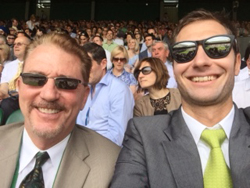
The members area has an outdoor patio and its own private bridge where you can look down at the other mere spectators as you cross over them on your way to center court.
There is an unbelievable indoor food and bar area. And yes the bar opens early. It's a charming English characteristic to drink alcohol at any hour of the day or night and often quite a lot of alcohol, but to absolutely refrain from showing any effect. Although one can be completely drunk, it is absolutely unacceptable to appear that way.
It turns out the classic Wimbledon drink the Pimm's Cup is "only" 25% booze by volume. That would be dry gin, some form of liqueur, fruit juices, lemon soda and spices. That seemed potentially deadly to me, but judging from what I saw, many of the members had built up very good tolerance over many years.
Giancarlo and I did cultivate another member vice however: scones with clotted cream and jam. Clotted cream does not refer to the affect on your arteries, but rather the process of making it by heating regular cream and them separating the clots that form on top--it's in between cream and butter but for some reason sweeter.
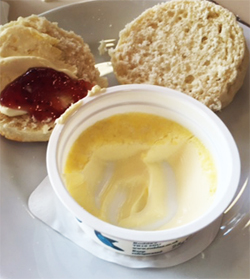
I held myself to one plate each day, but I must report that Giancarlo weakened and may have came close to overdose on the second day. Learning from his environment he didn't let the excess show.
You can't get clotted cream in the states, but they will ship it to you from Britain. The cost is $1/ounce--about the same as filet mignon, and that's not counting the shipping, but I am thinking about ordering some anyway. Hey I didn't say everything I learned at Wimbledon was about tennis.
The Conference
But I did learn more about tennis at the conference. For the first time, I got a chance to see Miguel Crespo from the International Tennis Federation present, and also to spend some time chatting with him about working together on biomechanical projects in the future.
I caught up with my old friend Sven Groeneveld--he just turned 50! He did a very interesting presentation on the pyschology of working with elite players and after his talk he gave us an interview on one of his main points: overcoming player resistance. It's up in this issue and you can read it here. (Click Here.)
We also had a chance to see Beni Linder present. Beni is the head of conditioning and physical training for the Swiss Tennis Federation and was mentored by Roger Federer's legendary physical trainer Pierre Paganini.
On court his energy was amazing. You may think you have seen every on court training drill ever invented--but I had not seen some of these. Or how effective they were when he demonstrated them with elite British juniors.
Giancarlo and I had arranged in advance to meet Beni (since they are both Swiss there was excellent first language communication...) and the outcome I hope is that we will be presenting an incredible new training series from him in the next year or so.
A big unexpected bonus was the location of the qualifying courts. Turns out they were adjacent to the national tennis center where the conference was held.
We were able to wander behind and even onto the sidelines of these absolutely gorgeous grass courts, see all these young juniors trying to qualify for the main junior event. Unlike the outer courts at Wimbledon, you can actually get down on your knees and feel and smell the grass.
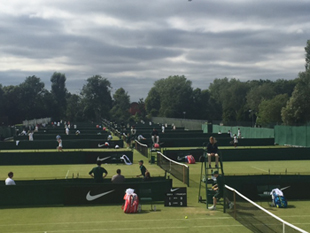
Then there was my presentation at the conference itself, which we have also published as two articles on Ultimate Fundamentals in the July issue (Click Here) as well as in the current August issue. (Click Here.)
I have wondered if my presentations using high speed video were getting repetitive for American coaches--or at least the ones who believe in continuing education and keep coming to conferences. But presenting to an entirely new group in England, I realized that this work can still make its way a long way in the world.
It was fantastic to see the response, to hear the questions, and have discussion. And to see a new group of coaches going on court physically modeling the key positions for themselves in the serve and forehand after in the presentation. All that was only reinforced by the experience that followed at Wimbledon on that incredible day at Center Court, watching the great players I had filmed so many times with only my naked eyes.




